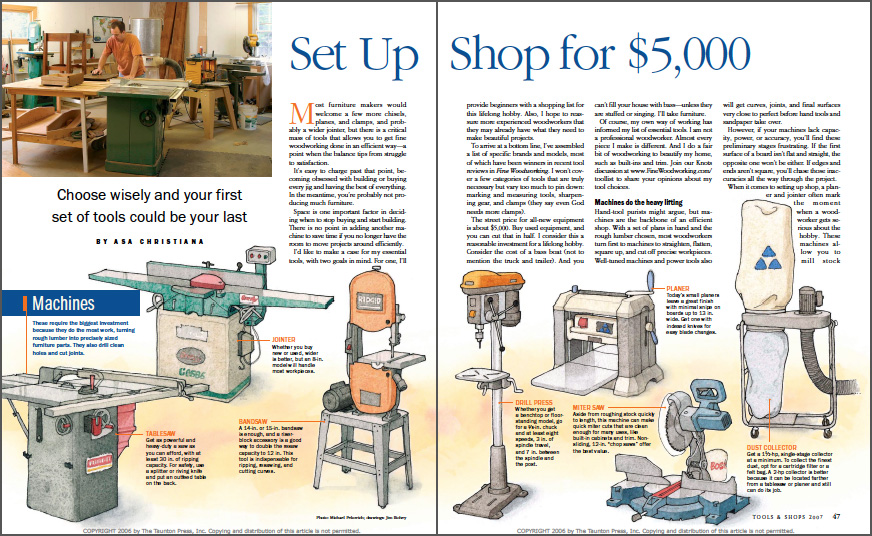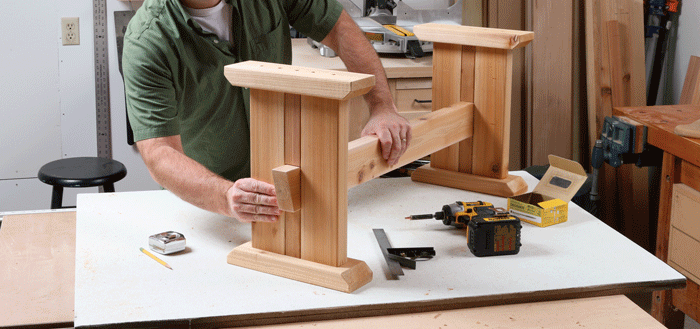Set Up Shop for $5,000
Choose wisely and your first set of tools could be your last.

Synopsis: Most furniture makers would welcome a few more chisels, planes, and clamps, and possibly a wider jointer, but there is a critical mass of tools that allows you to get woodworking done in an efficient way. When is it time to stop buying and start building? Editor Asa Christiana makes a case for his list of essential tools with two goals in mind. One is to provide beginning woodworkers with a shopping list for this lifelong hobby. Two is to reassure veterans that they may already have the tools they need to make beautiful projects.
On the list: tablesaw, 8-in. jointer, 14- or 15-in. bandsaw, drill press, miter saw, planer, dust collector, router kit and small detail router, cordless drill/driver, random-orbit sander, belt sander, circular saw, biscuit joiner, shop vacuum, three handplanes, dovetail saw, cabinet scraper, and chisels.
Most furniture makers would welcome a few more chisels, planes, and clamps, and probably a wider jointer, but there is a critical mass of tools that allows you to get fine woodworking done in an efficient way—a point when the balance tips from struggle to satisfaction.
It’s easy to charge past that point, becoming obsessed with building or buying every jig and having the best of everything. In the meantime, you’re probably not producing much furniture.
Space is one important factor in deciding when to stop buying and start building. There is no point in adding another machine to save time if you no longer have the room to move projects around efficiently.
I’d like to make a case for my essential tools, with two goals in mind. For one, I’ll provide beginners with a shopping list for this lifelong hobby. Also, I hope to reassure more experienced woodworkers that they may already have what they need to make beautiful projects.
To arrive at a bottom line, I’ve assembled a list of specific brands and models, most of which have been winners in recent tool reviews in Fine Woodworking. I won’t cover a few categories of tools that are truly necessary but vary too much to pin down: marking and measuring tools, sharpening gear, and clamps (they say even God needs more clamps).
The street price for all-new equipment is about $5,000. Buy used equipment, and you can cut that in half. I consider this a reasonable investment for a lifelong hobby. Consider the cost of a bass boat (not to mention the truck and trailer). And you can’t fill your house with bass—unless they are stuffed or singing. I’ll take furniture.
Of course, my own way of working has informed my list of essential tools. I am not a professional woodworker. Almost every piece I make is different. And I do a fair bit of woodworking to beautify my home, such as built-ins and trim. Join our Knots discussion at www.FineWoodworking.com/ toollist to share your opinions about my tool choices.
Machines do the heavy lifting
Hand-tool purists might argue, but machines are the backbone of an efficient shop. With a set of plans in hand and the rough lumber chosen, most woodworkers turn first to machines to straighten, flatten, square up, and cut off precise workpieces. Well-tuned machines and power tools also will get curves, joints, and final surfaces very close to perfect before hand tools and sandpaper take over.

From Fine Woodworking #188
To view the entire article, please click the View PDF button below.









Comments
> Grizzly G0586 8-in. Jointer $655
🤦♂️
Log in or create an account to post a comment.
Sign up Log in